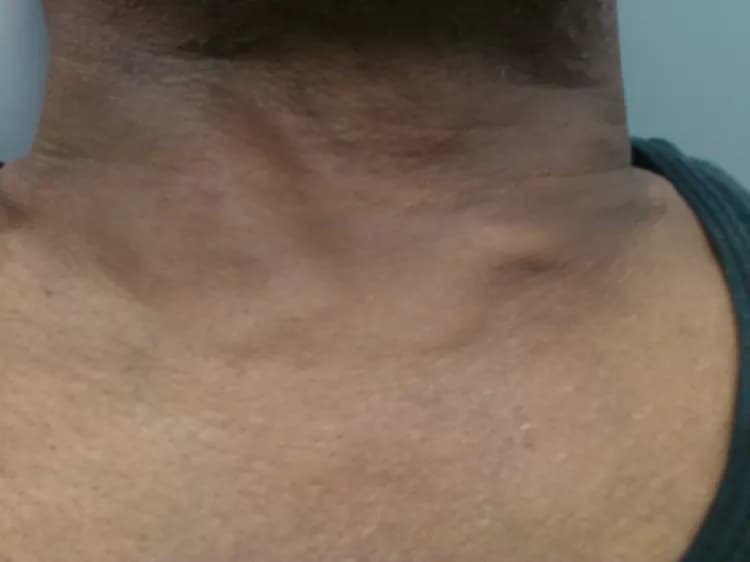
Subcutaneous Emphysema
What are the other Names for this Condition? (Also known as/Synonyms)
- Crepitus
- Subcutaneous Air
- Tissue Emphysema
What is Subcutaneous Emphysema? (Definition/Background Information)
- Subcutaneous Emphysema is a condition characterized by the presence of air in the tissues under the skin. It usually occurs on the chest, neck, and face, because air generally comes from the chest cavity
- Common causes of Subcutaneous Emphysema are penetrating or blunt trauma to the chest, neck, and face, corrosive or chemical burn injury of the esophagus, and some medical procedures such as endoscopy and bronchoscopy
- The condition results in chest and neck pain, difficulty breathing and swallowing. However, in normal cases, air build-up under the tissue does not cause any life-threatening symptoms
- Treatment of Subcutaneous Emphysema is directed at the underlying cause. In many cases, treatment is not required and the condition will resolve on its own; air gets gradually absorbed by the body over time and the prognosis is good
Who gets Subcutaneous Emphysema? (Age and Sex Distribution)
- Subcutaneous Emphysema can occur at any age depending upon the underlying causative factors
- There is no gender, racial, or ethnic predilection
What are the Risk Factors for Subcutaneous Emphysema? (Predisposing Factors)
Following are the risk factors of Subcutaneous Emphysema:
- Facial trauma
- Road traffic accidents
- Respiratory diseases
- Rib fractures
It is important to note that having a risk factor does not mean that one will get the condition. A risk factor increases one's chances of getting a condition compared to an individual without the risk factors. Some risk factors are more important than others.
Also, not having a risk factor does not mean that an individual will not get the condition. It is always important to discuss the effect of risk factors with your healthcare provider.
What are the Causes of Subcutaneous Emphysema? (Etiology)
Subcutaneous Emphysema is an uncommon condition. The possible causes for the same may include:
- Fractures of the facial bones, ribs
- Blunt trauma, diving injuries
- Pneumothorax (collapsed lung due to the presence of air between the lung and chest wall)
- Forceful vomiting
- Gunshot, stab wounds
- Chemical injuries affecting the esophagus that cause corrosion or burns
- Whooping cough (pertussis)
- Certain medical procedures such as endoscopy and bronchoscopy
What are the Signs and Symptoms of Subcutaneous Emphysema?
The signs and symptoms of Subcutaneous Emphysema may include:
- Pain in the neck, chest
- Swelling of the neck
- Trouble breathing and swallowing
- Crackling feeling to touch
- Crackles when inhaling and exhaling
- Changes in the voice
How is Subcutaneous Emphysema Diagnosed?
The diagnosis of Subcutaneous Emphysema may involve:
- Complete evaluation of medical history along with a thorough physical examination. During examination, the physician will look for:
- Presence of air bubbles and crackling sounds
- There may be evidence of swelling and skin discoloration within the affected region
- X-ray, CT scan, and ultrasound scan may be performed to evaluate and assess the affected region and to determine severity of the condition
Many clinical conditions may have similar signs and symptoms. Your healthcare provider may perform additional tests to rule out other clinical conditions to arrive at a definitive diagnosis.
What are the possible Complications of Subcutaneous Emphysema?
The possible complications associated with Subcutaneous Emphysema include:
- Respiratory problems
- Heart-related complications
- Skin abnormalities
How is Subcutaneous Emphysema Treated?
The treatment of Subcutaneous Emphysema is directed at the cause of the condition.
- Typically, air gets gradually absorbed by the body over time
- Rarely, a minor surgery or catheter is placed in the tissue to release the air
- Individuals with breathing difficulties may be given oxygen therapy
How can Subcutaneous Emphysema be Prevented?
Subcutaneous Emphysema can be prevented if proper precautions are taken early in the disease process (as the disease/condition progresses) responsible for the condition.
What is the Prognosis of Subcutaneous Emphysema? (Outcomes/Resolutions)
- The prognosis of Subcutaneous Emphysema is generally good. No life-threatening symptoms are associated with subcutaneous air build up
- In many cases, the condition resolve on its own and no treatment is required
Additional and Relevant Useful Information for Subcutaneous Emphysema:
Individuals, who present with rib fractures, are very likely to develop Subcutaneous Emphysema. Rib fractures harm the lung's protective layer and cause air leakage into the subcutaneous tissue, leading to this condition.
Related Articles
Test Your Knowledge
Asked by users
Related Centers
Related Specialties
Related Physicians
Related Procedures
Related Resources
Join DoveHubs
and connect with fellow professionals


0 Comments
Please log in to post a comment.